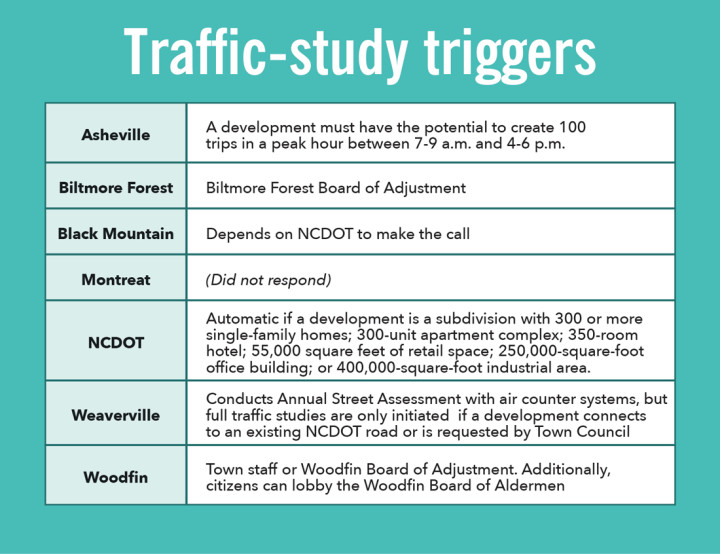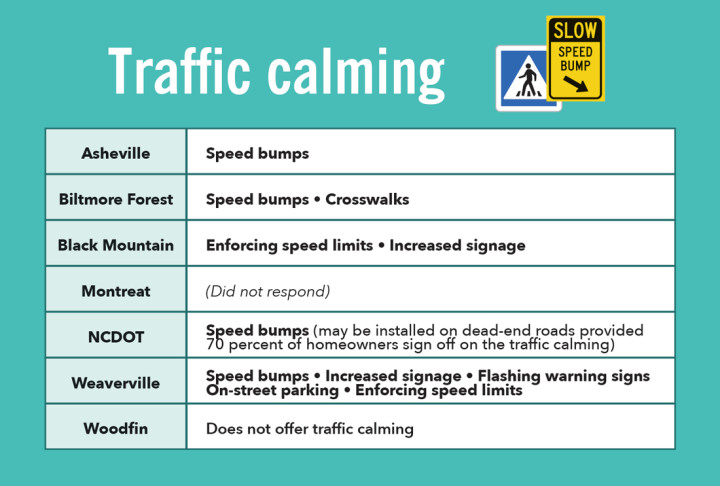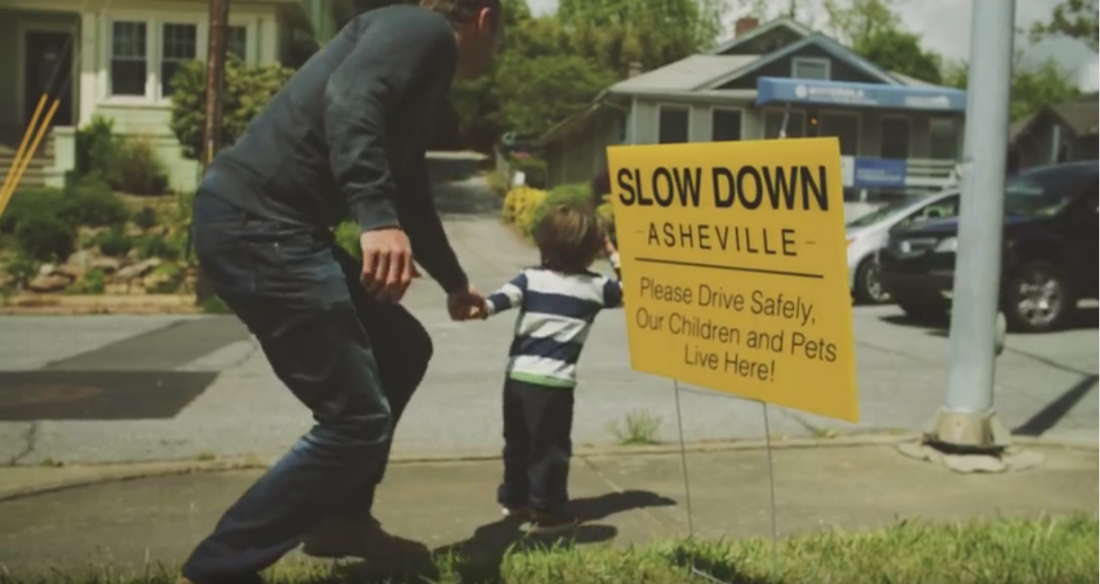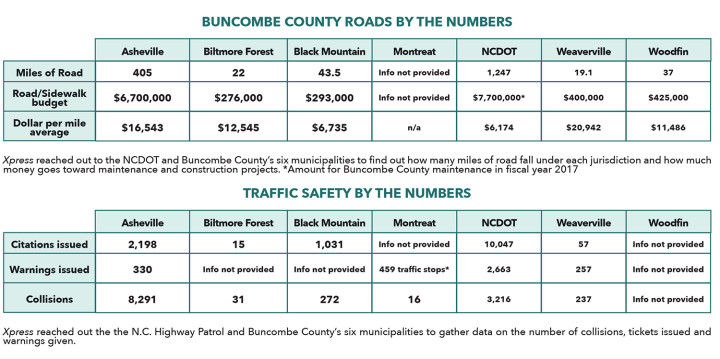ASHEVILLE, N.C.— In 1985, Doc Brown famously told Marty McFly: “Where we’re going, we don’t need roads.” Well, that proclamation about the state of infrastructure in a hypothetical 2015 turned out to be as fictitious as the Back to the Future character who voiced it.
Roads are still very much with us and, to hear most Buncombe County residents tell it, we need more rather than fewer to manage the traffic generated by a growing population.
Census data for Buncombe County show the population grew by 17,736 people, or by 7 percent, from 2010 to 2016. Nearly all of those new residents moved here from elsewhere, bringing with them a full complement of housing, employment and shopping needs — and the vehicle traffic that comes with them.
As residents struggle with lengthening commutes and worry about the safety implications of increased traffic volumes on once-quiet side streets, figuring out where to turn for help can be time-consuming and frustrating. While the North Carolina Department of Transportation controls 70 percent of Buncombe County’s roads, six municipalities also play a role in solving the traffic puzzle.
Bottlenecking
As new housing developments continue to proliferate throughout the county, increased traffic has some residents experiencing road rage and speaking out about infrastructure they see as overburdened. At Buncombe County Board of Adjustment meetings, for example, frustration about potential congestion often emerges when new projects come up for consideration. Residents frequently pack the forums, begging for relief in the form of roadway improvements.
Several sizable apartment projects were among those approved this year by the Board of Adjustment, including complexes of 472 units on Long Shoals Road, 255 units off Brevard Road, 214 units off Charlotte Highway and 232 units in the Chunns Cove area. The public hearings for each of those projects featured residents asking for help managing the traffic impact of the new units.
But board members generally tell citizens the fix is out of their hands.
Roads that lie within Buncombe County’s borders but outside of its six municipalities — Asheville, Biltmore Forest, Black Mountain, Montreat, Weaverville and Woodfin — are the responsibility of NCDOT Division 13. The agency also takes care of roads in Burke, Madison, McDowell, Mitchell, Rutherford and Yancey counties.
To get a driveway permit, new development along county roadways must meet NCDOT criteria. Mark Gibbs, Division 13’s maintenance engineer, says his office monitors new construction. “When a commercial, residential or industrial development is proposed, the [NCDOT] evaluates the impact on traffic and the need for road improvements at the access point and requires improvements as appropriate,” he explains.
Development projects likely to generate more than 3,000 vehicle trips per day must also undergo a traffic study, Gibbs explains. According to the Institute of Transportation Engineers’ website, a traffic study involves collecting and analyzing data to address a transportation problem or potential problem.
Project sizes that automatically trigger an NCDOT-required traffic study include: a subdivision with 300 or more single-family homes; 300-unit apartment complex; 350-room hotel; 55,000 square feet of retail space; 250,000-square-foot office building; or 400,000-square-foot industrial area. Depending on the results of the studies, Gibbs says, the NCDOT might require traffic mitigation efforts, which can include “left and right turn lane requirements, signalization and other possible improvements for very large developments.”
The NCDOT can’t require a traffic study on a road maintained by a municipality. The county’s six municipalities have varying standards for conducting a traffic study. (See inforgraph below, “Traffic-study triggers”)

After simmering discontent with traffic congestion in South Asheville reached the boiling point last year in the face of a proposed 272-unit apartment complex at Sweeten Creek and Mills Gap roads, community members asked the NCDOT to expedite plans for widening Sweeten Creek. Residents hoped to ease the gridlock they now experience during peak morning and afternoon travel times before the new complex generates even more traffic. But the answer was no.
“Projects such as Sweeten Creek Road are prioritized and funded as required by state law. This is a data-driven approach based upon factors such as safety, congestion, benefit, cost, etc., while allowing for local input,” says Ricky Tipton, Division 13’s construction engineer. “Since we use a data-driven approach to prioritize projects, we cannot just change the schedule.”
The NCDOT’s approach doesn’t make predictions about where traffic issues are likely to develop, Tipton explains. “This approach is geared more toward solving current deficiencies than trying to predict where problems may arise in the future,” he says. “Given our predicted needs, it is not likely that we will be able to invest in transportation based solely on predicted growth unless there is an existing deficiency.”
A calming effect
Frustrated commuters fed up with congestion often search for alternate routes to hasten the drive. But shortcuts aimed at shaving time off a commute can increase traffic volume and speeding on residential side streets that were never designed for heavy use. Often people living on such once-placid roads request traffic-calming measures.
The effectiveness of those measures varies, and the results can cause consternation. “I recently had a speed bump installed in our neighborhood. … It was left unpainted with no warning signs for two weeks. Many people’s cars suffered minor damage. I contacted [the county and city], but never got through to anyone about it,” says Woodfin resident Joseph Crowe. He’s also skeptical of some of the town’s other efforts, noting, “There are plenty of signs saying ‘Drive slow, children at play’ but no one thinks twice about them.”
Jason Young, administrator for the town of Woodfin, says traffic calming is an evolving process. “The town has, in the past, pursued avenues for traffic calming by installing signs and enforcing speed limits on public roads. And by encouraging, where appropriate, on-street parking as a cost-effective means of traffic calming. Recently, the town has adopted flashing warning signs at certain specific spots and has initiated a pilot project with speed bumps,” he says, adding that the town plans to study the effectiveness of the newer initiatives.
Meantime, Biltmore Forest Town Manager Jonathan Kanipe says he considers speed bumps installed on three roads a success. A crosswalk on Stuyvesant Road near the Biltmore Forest Country Club has also proven effective at reducing speeds. “This crosswalk slows traffic considerably and allows safe passage of pedestrians, golf carts and others who are using this section of the road.”
However, not everyone sees installing traffic-calming measures as a best practice. Weaverville Public Works Director Tony Laughter says he believes the measures create unintended consequences. “Several locations nationwide have discovered these calming options briefly slow not only traffic but consume [emergency] responders’ precious seconds in a life-and-death emergency. I do not speak for the area emergency personnel. After being asked to consider the cost and installation of such devices, I did my own research and reached my own conclusion,” he explains.
And, Laughter says, many calming measures seem to encourage short-distance bursts of speed. “I have personally witnessed a drag-race-type acceleration between the calming devices to make up the time lost going over the obstacle — many times exceeding the speed they would have normally traveled in the absence of such device.” (See infograph below, “Traffic calming” for more information on traffic-calming measures from the NCDOT and the county’s six municipalities)

Slow your roll
Where congestion isn’t an issue, speeding often is. Many county residents see their roads menaced by tardy commuters angling to make up for lost minutes. Signs urging drivers to “Slow down, Asheville” and “Drive like your kids play here” testify to the need for speed and the difficulties facing those who hope to control it.
All speed limits in Buncombe County are set by the NCDOT. Gibbs explains that the statutory speed limit for rural areas is 55 mph, while the limit in incorporated municipalities is 35 mph. “Non-statutory speed limits are determined by traffic engineering studies, which include a field review of the development and characteristics of the road, a traffic count to verify the amount of traffic traveling on the road, a speed study to determine the prevailing vehicle speeds and a crash study,” Gibbs says.
While Buncombe County is not responsible for road construction and maintenance, the Sheriff’s Department does spend some time enforcing speed limits. “The Sheriff’s Office typically conducts speeding campaigns as part of our Community Oriented Problem Solving (COPS) teams, particularly if the community which the team is assigned has listed speeding as an issue,” says Natalie Bailey, spokesperson for the department. However, questions about how citizens can request such speeding enforcement campaigns went unanswered. The Sheriff’s Department also partners with the Asheville Police Department on the DWI Task Force.
The N.C. Highway Patrol rolls out numerous safety campaigns throughout the year, with speeding a component of all of them. “Speeding is among the many violations we focus on to reduce collisions, as excessive speed is the leading cause of traffic fatalities statewide,” says Sgt. Michael Baker, spokesperson for the N.C. Highway Patrol. Beyond statewide campaigns, he says, local leadership may choose to emphasize specific priorities such as speed enforcement.
Baker adds that if you live or drive in an area that could benefit from speed enforcement, you can contact the N.C. Highway Patrol to request such an effort. (See infograph below, “Speeding Enforcement” for more on enforcement and awareness campaigns)

Mean streets
Gwen Wisler, Asheville’s vice mayor, is an appointed member of the board of the French Broad River Metropolitan Planning Organization, which helps coordinate transportation planning among local and state government and federal agencies. According to its website, the FBRMPO includes representatives from Buncombe, Haywood, Henderson, Madison and Transylvania counties, as well as a number of municipalities in those counties. The board also serves as a forum for public input.
Wisler notes that elected officials are aware of public concerns over traffic hot spots. “Working on the MPO, you start to get familiar with how the NCDOT works. Thinking about traffic, understanding a little more about how they go about prioritizing projects,” she says. “I don’t know that they are proactive, in the sense that they are trying to predict where development is going to be in the future and therefore build out infrastructure. I think they kind of wait until the development is there, and then the neighborhoods think it’s too late.”
However, she urges those advocating for traffic mitigation efforts to fight on. “Don’t give up on the NCDOT. They are getting better and better at listening. … Do they always do something about it? Not necessarily. But what I would encourage the readers to do is weigh in,” she advises. “Go to these public meetings. They do listen and they are required to listen.”









I see a lot of complaints in Asheville about traffic, but I’ve never seen any in the two decades I’ve lived in Buncombe County. Where are these bumper to bumper jams lasting half an hour at a time? Can anybody videotape one and get back to me?
Obviously some areas have trouble with slow lights, and people don’t like it when traffic avoids main routes to shortcut through residential neighborhoods, but neither of of those are serious traffic issues.
Based on the apparently invisible jams and delays, I’m inclined to think this is yet another anti-development rhetorical tactic on part of rich immigrants to make sure that affordable high density housing isn’t built in Asheville.
It seems you are given to conspiracy theories and you must work 3rd shift if you have not experienced congestion on our streets. “Rich immigrants ” are not internally keeping housing prices higher, that is just a result of our capitalist economic policies . Drivers cutting through side streets to avoid traffic is a very serious issue for those people who live on these streets. The automobile was responsible for 40,000 deaths last year and hundreds of thousands of injuries. This is analogous to someone walking down your street randomly firing a weapon. Would you want either of these on your street or dirt lane?
Again, I’d like to see video evidence of these giant delays and congestion. Rather than evidence of totally ordinary traffic patterns.
And no, ‘capitalist economic policies’ are not what’s keeping our vacancy rates so low. It’s a housing shortage. Lots of people move here, there are not enough places to live compared to demand. Therefore, prices are high.
Drivers ‘cutting through’ is a natural result of inefficient pathing as a result of not having enough housing close to places of employment, resulting in people having to pass through other residential neighborhoods to reach amenities and workplaces. Again, a problem solved by building more housing near arterial paths.
But none of this will happen so long as immigrants are obsessed with stopping other immigrants from increasing population density in Asheville. NIMBY junk strikes again.
Obviously someone’s perception of what constitutes traffic congestion is relative to their experiences living else where but the consensus here is it is a problem. Although in one aspect congestion is a sign of the economic health of a city. Lots of traffic implies people want to be here. The issue lies in how to transport and house everyone efficiently.
The laws of supply and demand are a major part of our Capitalist system.
Drivers use the mainly residential side streets out of a selfish desire to beat the traffic . Now obviously if the infrastructure was designed for more efficient transport this wouldn’t be such an issue. I addressed TOD in an earlier post
I agree we need to develop and implement better infill policies which the city council has been doing. But the city is small compared to the rest of the county whose residents typically resist infill policies (NIMBY’s)
My apartment sits off of Long Shoals Rd and has a bus stop at the entrance. I can also walk to get much of what I need on a daily basis.
I feel as more people move here the NIMBY’s will have to relent and learn to live in higher density neighborhoods.
“Based on the apparently invisible jams and delays”
I’ll assume good faith. Perhaps you moved from L.A. or Atlanta and that’s the hard standard you apply. Perhaps you live in Alexander and don’t get out much. Perhaps you work third shift. Perhaps you’re a vampire and can only go out at 4pm in December. Perhaps you do all your travel by helicopter. In all of those cases, your impressions may be correct, but they don’t carry much value in making a case.
You’re right that I’ve lived in places with actual traffic problems before, where it takes half an hour to drive a handful of miles. I’ve also lived here for well over two decades and seen the city go from no-traffic-ever to typical rush traffic for a mid-major regionally important city. Is this supposed to be an argument against me? “Well of course someone with experience of very heavy traffic would think our traffic isn’t bad!” You’re making my point for me.
I hear “your impressions aren’t valid,” but I see no evidence against. Come on, if it’s so obvious that Asheville has major traffic issues, somebody tell me what evidence there is for these major jams and delays? Otherwise it seems that I should dismiss your impressions just as easily as you dismiss mine.
One of the most significant restrictions on high-density housing and associated infrastructure in Asheville is a large private estate and a subdivision micro-city for rich people in its southwest quadrant. The map is the map. Another is the prohibition on involuntary annexation, which creates incentives to build sprawly car-dependent residential developments under county/NCDOT jurisdiction. At some point your free-market sensibility runs into a wall.
“Come on, if it’s so obvious that Asheville has major traffic issues, somebody tell me what evidence there is for these major jams and delays?”
See, it doesn’t work that way. If, for instance, someone points to how Hendersonville Road’s traffic south of the Parkway to Long Shoals now slows to a crawl at lunchtime as well as morning/evening rush hours, you’ll just say “well, that’s to be expected, naive provincials.” Not playing those reindeer games.
Simply look on Google maps traffic. I-26 backs routinely all the way to Hendersoville sometimes.
Growth is inevitable and is actually a key tenet in our Capitalist society. Either grow or wither on the vine. What is not inevitable is the addition of more automobiles onto our already crowded streets. Cities around the world have begun to tie housing development in with transit infrastructure. By utilizing the principles of Transit Oriented Design you get the needed housing without the increase in traffic.
The automobile is so ubiquitous in our society that many cannot fathom life without it. Their entire view of the world is from behind a windshield. Many have sat in the driver’s seat for so long they have lost the ability or desire to walk. Look how much drivers complain about the lack of parking. The automobile has become synonymous with the American ideal of individualism and mobility at the expense of our health and the health of the planet. The time as come for people to wake up to the realization the automobile has become a bane to our very existence.
Obviously the solution lies in providing more alternative means of transport but these systems are costly and the demand is currently low due to people’s obsession with their automobiles. More people need to take the initiative and leave their cars parked at home and utilize the bus, bike or even ride share as a way of getting around. I realize our bus system is underdeveloped but it is still adequate enough for most residents if only they made the effort to use it. It would seem evident to me that with increased ridership the City and the Bus Transit Authority would be motivated to increase funding for expanded service.
Good luck with your great ideas. I will NEVER ride the bus. EVER. I own several cars and motorcycles. I like to drive and use gas. Sue me. Not everybody will agree with your idea of people just need to park their cars and skip to work. I routinely travel from West Asheville to downtown to South Asheville on a daily basis. The bus does not help me, nor can I tolerate the slugs riding the bus. I’ve lived in Asheville for 38 years. Gentrification is the best thing that has happened to this town in that time. This city is great and is getting better daily.
These are not my ideas, I am just the messenger and ardent follower. You do realize that gentrification normally carries with it a reduction in automobile use and an increase participation in alternate modes of transit? But you are correct in one aspect when you say the city is getting better for they are actively involved in reducing dependence on the automobile by providing access to active transit. I am not sure what part of West Asheville you reside but there are 3 ART busses that service West Asheville. It is also a short bicycle ride or a relatively long skip. While I agree in part some of the bus riders are hard to tolerate, but to refer to them as slugs is pretty harsh.
Your comment painted a picture in my mind of hordes of Ashevilleans skipping to work of a morning, and I must say, it’s a rather delightful image.
Yea it would cut down on the road rage, hard to be mad when you are skipping along
Oh, bless the Biltmore Forest guy and his concern about golf carts. Isn’t traffic management in B.F. having the locals call the cops when they see someone driving around in a non-luxury car? I tease, but only slightly: when your municipality is built with no thru-roads (excepting, just about, the Parkway) then you manage it like a giant subdivision. Montreat isn’t much different.
The problem, as ever in the county, is the mangle of jurisdictions. Build a 298-unit complex on unincorporated land and it won’t trigger NCDOT’s traffic study threshold, even if it creates a knock-on effect for city traffic.
Simple fix. Stop making it so easy to acquire a drivers license, Tthe US needs to adopt Germany’s licensing process and highway laws.
And it wouldn’t hurt to implement laws concerning reproduction. The rampant uncontrolled consumption of resources needed to slow down years ago.
Few years later in 2019 traffic has increased by loads. i26 is rarely not busy. Bumper to bumper traffic is so normal on that interstate. If there’s 1 issue on 26 it gridlocks the rest of south Asheville with heavy congestion. Standstills have been happening for years on Hendersonville rd and sweeten creek. With 11.1 million tourists in 2017. Asheville is poised with this and we need to fix our outdated roads.